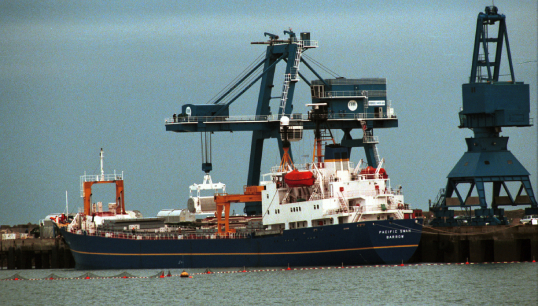Pacific Swan

Special design
Built at Swan Hunter’s Hebburn yard, the vessel had been specially designed in collaboration with the Salvage Association and the Japanese Ministry of Transport, following the introduction of the world’s first specialist nuclear fuel carrier, Hinoura Maru, in 1978.
Before Pacific Swan came into service, nuclear waste and other radioactive materials had been carried on specially adapted cargoships, such as James Fisher’s Leven Fisher, Pool Fisher and Stream Fisher.
Recognising the potential safety and environmental risks posed by such shipments, and in response to concerns raised by its fishing industry, Japan had drawn up design criteria for vessels transporting radioactive cargoes.
These rules – covering such points as structural strength, collision protection, damage stability, cargo monitoring, cooling systems, fire-fighting and emergency equipment – were closely followed in the construction of Pacific Swan.
The build
Built for Pacific Nuclear Transport Ltd (PNTL), with the core role of shipping irradiated fuel from Japan to the UK’s Sellafield reprocessing centre in its five holds, the twin-screw ship was powered by two eight-cylinder Ruston diesels, producing 4,070bhp and giving a service speed of 13 knots.
Featuring double hulls, double bottoms and twice the void space required of tankers, Pacific Swan was designed to withstand a collision with a 24,000-tonne ship travelling at 15 knots. All essential systems – such as power generation, propulsion and steering – were duplicated and separated, and the ship also featured dual navigation, communications and monitoring systems.
Code maker
The construction and operating criteria used for Pacific Swan and subsequent sisterships Pacific Crane and Pacific Teal formed a key part of the International Maritime Organisation’s Code for the Safe Carriage of Packaged Irradiated Nuclear Fuel, Plutonium and High-Level Radioactive Wastes on board Ships, introduced in 1993.
While PNTL routinely pointed to the safety of the Pacific sister ships, their cargoes – including used nuclear fuel, vitrified high-level nuclear waste, mixed oxide (MOx) fuel and plutonium – proved increasingly controversial. Countries including Argentina, Australia, South Africa and New Zealand sought to bar the ships from their waters and in 1995 a Chilean naval vessel escorted Pacific Swan away from the country’s EEZ, preventing it from using the Straits of Magellan.
Environmental issues
In February 1998 Pacific Swan was pitched into the centre of a major international row after being boarded by activists from the environmental group Greenpeace in the Panama Canal. Greenpeace claimed its action had exposed the vulnerability of nuclear shipments and it called for the carriage of intensely radioactive, vitrified high-level waste through the Panama Canal to be banned while the ‘thoroughly inept and ineffective’ security arrangements were investigated.
However, Pacific Swan made further voyages carrying high-level nuclear waste and MOX fuel between Europe and Japan over the following years, until going into lay-up early in 2004 after PNTL said it had ‘completed all its scheduled work’. In January 2005, after being certified free of any radiological contamination, the vessel arrived at ’s-Gravendeel for breaking up and recycling by Scheepsloperij Nederland.
Pacific Swan fact file
How fast was Pacific Swan?
Pacific Swan had a service speed of 13 knots.
Which country’s navy escorted Pacific Swan from its waters?
A Chilean Navy vessel escorted Pacific Swan from Chilean waters in 1995.
Where was Pacific Swan when it was boarded by Greenpeace?
Pacific Swan was in the Panama Canal when it was boarded by Greenpeace in 1998.
Contribute
Are you knowledgeable about this vessel?
Submit your contribution to this article to our editorial team.
Write to usView more ships of the past
HMS Beagle
Launched 200 years ago, HMS Beagle has been described as one of the most important ships in history – thanks to the observations on evolution and natural selection that its famous passenger Charles Darwin made during a five-year voyage around the world between 1831 and 1836.
Common.ReadMoreHMS Beagle
Oxfordshire
The Oxfordshire had a 34-year long career as an emigrant ship, passenger liner and cruiseship.
Common.ReadMoreOxfordshire
Ruahine
Entering into service just over 70 years ago, the Ruahine was the last passenger-carrying ship built for the New Zealand Shipping Company (NZSC), and the third to bear the name – which means 'wise woman' in Māori.
Common.ReadMore